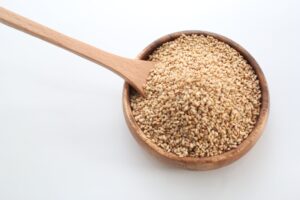Sesame Allergy
 Allergic reactions to sesame are increasing in incidence over the past several years. Sesame is the 9th most common food allergy among children and adults. Approximately 0.23% of the U.S population are allergic to sesame. Although 0.23% seems like a small number, the National Institute of Health’s (NIH) researchers estimate that 17% of food-allergic children have a sesame allergy.
Allergic reactions to sesame are increasing in incidence over the past several years. Sesame is the 9th most common food allergy among children and adults. Approximately 0.23% of the U.S population are allergic to sesame. Although 0.23% seems like a small number, the National Institute of Health’s (NIH) researchers estimate that 17% of food-allergic children have a sesame allergy.
In the past, according to the Center for Science in the Public Interest, only 14 out of 22 major food companies clearly labeled sesame ingredients on their product labels. However, on April 23, 2021, the FASTER (Food Allergy Safety, Treatment, Education, and Research) Act was passed into law. This law requires that sesame be labeled on all packaged foods in the United States. This sesame labeling began earlier this year on Jan. 1, 2023.
Sesame joins the 8 other foods that are already declared as major food allergens by federal law. The 9 major food allergens are as follows:
- Milk
- Eggs
- Fish (e.g., bass, flounder, cod)
- Crustacean shellfish (e.g., crab, lobster, shrimp)
- Tree nuts (e.g., almonds, walnuts, pecans)
- Peanuts
- Wheat
- Soybeans
- Sesame
The protein that is contained in sesame seeds, sesame oil, tahini, etc. binds to the specific antibodies in one’s serum and causes reactions that cause the release of histamine and other chemical mediators which are responsible for the allergic symptoms that occur. Most allergic reactions to sesame are caused by oleosins, the proteins in sesame.
Symptoms:
Individuals with a sesame allergy may experience a variety of symptoms that can range from mild to severe. The symptoms may include itchiness of the throat or mouth, generalized itching (i.e., pruritus), hives (i.e., urticaria), swelling (i.e., angioedema), nausea, vomiting, diarrhea, abdominal pain, flushing of the face, hoarseness, coughing, wheezing, and/or shortness of breath
A person with a severe reaction to sesame may experience anaphylaxis. Anaphylaxis is a life-threatening reaction that requires immediate medical attention. Some of the symptoms of anaphylaxis may include hives, shortness of breath, generalized itching, swelling, wheezing, fainting, dizziness, drop in blood pressure, rapid heartbeat, and/or cardiac arrest. Individuals who experience anaphylaxis due to sesame should carry a self-injectable epinephrine device (e.g., EpiPen, Auvi-Q, Adrenaclick) with them at all times. If the self-injectable epinephrine device is used, they should go immediately to the closest emergency room.
In packaged foods manufactured prior to January 1, 2023, sesame may appear undeclared in ingredients such as flavors or spice blends.
Some foods that may contain sesame:
- Asian cuisine – Sesame oil is commonly used in cooking
- Baked goods (e.g., bagels, bread, breadsticks, hamburger buns, rolls)
- Bread crumbs
- Cereals (e.g., granola, muesli)
- Chips (e.g., bagel chips, pita chips, tortilla chips)
- Crackers (e.g., melba toast, sesame snap bars)
- Dipping sauces (e.g., baba ghanoush, hummus, tahini sauce)
- Dressings, gravies, marinades, and sauces
- Falafel
- Hummus
- Flavored rice, noodles, risotto, shish kebabs, stews and stir fry
- Goma dango (i.e., Japanese dessert)
- Goma dofu (i.e., Japanese sesame “tofu”)
- Herbs and herbal drinks
- Margarine
- Pasteli (i.e., Greek dessert)
- Processed meats and sausages
- Protein and energy bars
- Snack foods (e.g., pretzels, candy, Halvah, snack mix, rice cakes)
- Soups
- Sushi
Some non-food items that may contain sesame:
- Cosmetics
- Medications
- Supplements
- Pet food
Diagnosis:
Skin Prick Testing – A safe and low-risk test in which the skin is lightly pricked with a suspected allergen. This can result in a raised bump or hive, with more severe reactions pointing to a greater likelihood of an allergy.
Blood Test – Measures the amounts of IgE antibodies (i.e., “allergy” antibodies) that the immune system has deployed as an allergic response to sesame.
Like tree nut allergies, sesame allergies are sometimes cross-reactive. In other words, if you are allergic to sesame, you could be allergic to similar seeds and nuts.
Treatment:
Mild allergic reactions to sesame can be treated with antihistamines. Systemic reactions with generalized symptoms needs to be treated with injectable epinephrine.
Prevention:
Diligent reading of the labels and strict avoidance of exposure to all sesame-containing products is necessary in order to prevent allergic reactions to sesame. Most patients with sesame allergy unfortunately do not “outgrow” the sensitivity.
If you suffer from or suspect a sesame allergy or any other type of allergy, the board certified allergists at Black & Kletz Allergy have the expertise in diagnosing and treating your condition. We treat both pediatric and adult patients and have offices in Washington, DC, McLean, VA (Tysons Corner, VA), and Manassas, VA. We have on-site parking at each location and both the Washington, DC and McLean, VA offices are Metro accessible. Please either call us for an appointment or you may alternatively click Request an Appointment and we will respond within 24 hours by the next business day. The allergy specialists at Black & Kletz Allergy have been treating allergy, asthma, and immunology patients in the Washington, DC metropolitan area for more than 5 decades and we strive to provide state-of-the-art allergy care to its residents and visitors.
